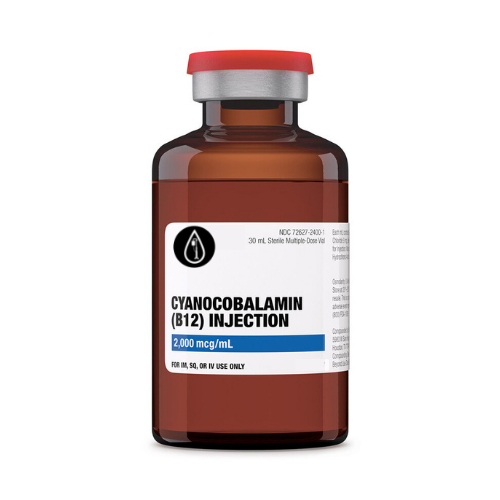Vitamin B-12 Injection
Cyanocobalamin (B12) - Information
Written by: Taylor J. Graber MD
Updated: October 22nd 2022
Main Source of Information: Empower
Vitamin B-12, in the form of Cyanocobalamin, is very helpful for increasing energy and fatigue, can help treat megaloblastic anemia and improve DNA repair.
Overview of Cyanocobalamin (B12) Injection
General Information
Cyanocobalamin is a vitamin of the B-complex family, commonly known as cobalamins (corrinoids). It is a synthetic or man-made form of vitamin B12 that is available as both a prescription and over-the-counter (OTC) medication. Cobalamins exist in several other chemical forms, including hydroxocobalamin, methylcobalamin, and adenosylcobalamin (1,2). Cyanocobalamin is the most common form of cobalamins used in nutritional supplements and fortified foods. It contains a cyano (cyanide) group in its structure, which makes it more stable than other forms of vitamin B12 as the cyanide stabilizes the molecule from deterioration. Hydroxocobalamin, however, is the most biologically active form of Vitamin B12; hence, it is more preferable than cyanocobalamin for the treatment of vitamin B12 deficiency (1,2,3,4).
Cyanocobalamin does not naturally exist in foods owing to the presence of cyanide, which is absent in the natural form of the vitamin. The chemical structure of cyanocobalamin contains the rare mineral cobalt (4.34%), which binds the cyano group and is located in the center of a corrin ring (5). The commercial manufacturing of the vitamin is done through bacterial fermentation. Compared to other forms of vitamin B12, it is easier to crystallize and more air-stable.3Cyanocobalamin is usually obtained as a dark red, amorphous or crystalline powder, orthorhombic needles, or red crystals. The anhydrous form of the compound is highly hygroscopic. It may absorb up to 12% of water if exposed to air. Cyanocobalamin is sparingly soluble in alcohol and water (1 in 80 of water), but insoluble in chloroform, acetone, and ether. The coenzymes of this vitamin are highly unstable in light (6).
Cyanocobalamin is available in several dosage forms including the tablet, nasal spray, and injection. The US-FDA initially approved the drug in 1942 (7). However, the compound became widely available for routine use in the treatment of B12 deficiency in the early 1950s (8).
Contraindications/Precautions
Cyanocobalamin is contraindicated in those with hypersensitivity to cobalt moiety or cobalamin molecule due to the risk of anaphylaxis (9).
Warnings:
The use of cyanocobalamin is warned in patients with early Leber’s disease as there have been reports of severe and swift optic atrophy with its administration. Appropriate caution should be exercised while treating severe megaloblastic anemia with cyanocobalamin as intense treatment may lead to hypokalemia and sudden death. Cautious use of parenteral cyanocobalamin is also recommended in patients with renal impairment, including premature neonates, because of the possibility of greater aluminum accumulation, which may cause central nervous system and bone toxicity. Formulations of cyanocobalamin injection containing benzyl alcohol as a preservative should also be avoided in premature neonates and those with hypersensitivity due to its association with ‘gasping syndrome (10-12).
Monitoring:
A history of the patient’s allergies/hypersensitivity should be obtained before administering cyanocobalamin injection. If the patient is suspected to be sensitive to cobalt or other components of cobalamin, an intradermal test dose is recommended (10, 13).
Several laboratory tests should be performed prior to treatment with cyanocobalamin, including serum vitamin B12, folate, iron, hematocrit, and reticulocyte count. All these parameters need to be normal before initiating the treatment. Serum levels of vitamin B12 and peripheral blood counts should be monitored in one month. For hematocrit and reticulocyte counts, recommendations are to repeat these tests daily from the 5th to 7th days of treatment and then frequently until the hematocrit returns to a normal range (11, 14, 15).
Both serum potassium concentrations and the platelet count need to be monitored carefully after parenteral administration of cyanocobalamin. This is because hypokalemia and thrombocytosis could occur due to the increase in erythrocyte metabolism following vitamin B12 therapy. Potassium replacement therapy should be administered if necessary (10, 13).
Patients with pernicious anemia are three times more likely to have gastric carcinoma compared to general population; thus, appropriate tests need to be carried out to rule out this condition if suspected (11).
Therapeutic response to cyanocobalamin may decrease due to elderly age, infection, renal insufficiency, diabetes mellitus, marrow suppressants use (e.g. chloramphenicol), and concurrent iron or folic acid deficiency (13, 16). Therefore, these factors should be taken into consideration and regular monitoring should be performed in these conditions while treating vitamin B12 deficiency with cyanocobalamin.
Pregnancy
Cyanocobalamin is a medication of the FDA pregnancy category C. Up to now, no adequate and well-controlled reproduction studies have been conducted in humans and animals to determine its effects on pregnant women (17). However, there is also no reports of maternal or fetal harms with the ingestion of normal daily recommended amounts during pregnancy. In fact, the requirements for vitamin B12 increase during pregnancy. Therefore, parenteral cyanocobalamin should be administered to a pregnant woman if the benefits outweigh the risks (10, 11).
Breastfeeding
Cyanocobalamin is excreted in the breast milk of nursing women in levels similar to the level of vitamin B12 in maternal plasma (18). The distributed cyanocobalamin in breast milk has been found to be compatible with breastfeeding by the American Academy of Pediatrics (19). In addition, there has not been any reports of adverse effects associated with the intake of normal daily requirements of vitamin B12 during lactation. The Food and Nutrition Board, the National Academy of Sciences-National Research Council recommend that lactating women should consume 4 mcg of vitamin B12 daily (11).
Adverse Reactions/Side Effects
Vitamin B12 is known to be non-toxic even in high doses. The reported adverse reactions following parenteral administration of vitamin B12 include:
Generalized: Anaphylaxis and death
Cardiovascular: Pulmonary edema and congestive cardiac/heart failure during early treatment; peripheral vascular thrombosis
Hematological: Polycythemia vera (a rare type of blood cancer)
Gastrointestinal: Mild, transient diarrhea
Dermatological: Itching; transitory exanthema (widespread skin rash)
Miscellaneous: Feeling of swelling of entire body
Storage
Store this medication at 68°F to 77°F (20°C to 25°C) and away from heat, moisture and light. Keep all medicine out of the reach of children. Throw away any unused medicine after the beyond-use date. Do not flush unused medications or pour down a sink or drain.
References
Markle HV, Greenway DC. Cobalamin. Critical reviews in clinical laboratory sciences. 1996; 33: 247-356.
Herrmann W, Obeid R. Cobalamin deficiency. Subcell Biochem. 2012; 56: 301-322.
Paul C, Brady DM. Comparative Bioavailability and Utilization of Particular Forms of B12 Supplements With Potential to Mitigate B12-related Genetic Polymorphisms. Integrative Medicine: A Clinician’s Journal. 2017; 16: 42–49.
Vidal‐Alaball J, Butler C, Cannings‐John R, Goringe A, Hood K, McCaddon A, McDowell I, Papaioannou A. Oral vitamin B12 versus intramuscular vitamin B12 for vitamin B12 deficiency. Cochrane Database of Systematic Reviews. 2005: CD004655.
O’Leary F, Samman S. Vitamin B12 in health and disease. Nutrients. 2010; 2: 299-316.
Sweetman SC, editor. Martindale: the complete drug reference, 34th ed. London: Pharmaceutical press; 2014.
CaloMist™ Nasal Spray (cyanocobalamin, USP) label. 2007. Available from: https://www.accessdata.fda.gov/drugsatfda_docs/label/2007/022102s000lbl.pdf [Accessed October 23, 2020].
Berry RJ. Lack of historical evidence to support folic acid exacerbation of the neuropathy caused by vitamin B12 deficiency. The American journal of clinical nutrition. 2019; 110: 554-61.
Caballero MR, Lukawska J, Lee TH, Dugué P. Allergy to vitamin B12: two cases of successful desensitization with cyanocobalamin. Allergy. 2007; 62: 1341-1342.
CYANOCOBALAMIN INJECTION, USP 1000 mcg/mL Sterile (Vitamin B12) [Label]. 2014. Available from: https://pdf.hres.ca/dpd_pm/00026115.PDF [Accessed October 26, 2020].
CYANOCOBALAMIN- cyanocobalamin injection, USP. West-Ward Pharmaceuticals Corp [Label]. 2018. Available from: https://dailymed.nlm.nih.gov/dailymed/fda/fdaDrugXsl.cfm?setid=a66eb3c4-3e1d-4d49-b963-4fa2334cc9b6 [Accessed October 26, 2020].
Nascobal® (Cyanocobalamin, USP) Nasal Spray 500 mcg/spray 0.125 mL [Label]. 2014. Available from: https://www.accessdata.fda.gov/drugsatfda_docs/label/2014/021642s020lbl.pdf [Accessed October 26, 2020].
Vasavada A, Sanghavi D. Cyanocobalamin. In: StatPearls [Internet] 2020. StatPearls Publishing.
Alamin A, Gupta V. Vitamin B12 (Cobalamin). In: StatPearls [Internet]. 2020. StatPearls Publishing.
Carmel R. How I treat cobalamin (vitamin B12) deficiency. Blood. 2008; 112: 2214-2221.
Solomon LR. Disorders of cobalamin (vitamin B12) metabolism: emerging concepts in pathophysiology, diagnosis and treatment. Blood reviews. 2007; 21: 113-130.
Chandyo RK, Ulak M, Kvestad I, Shrestha M, Ranjitkar S, Basnet S, Hysing M, Shrestha L, Strand TA. The effects of vitamin B12 supplementation in pregnancy and postpartum on growth and neurodevelopment in early childhood: Study Protocol for a Randomized Placebo Controlled Trial. BMJ open. 2017; 7: e016434.
Samson RR, McClelland DB. Vitamin B12 in human colostrum and milk: quantitation of the vitamin and its binder and the uptake of bound vitamin B12 by intestinal bacteria. Acta Pædiatrica. 1980; 69: 93-99.
American Academy of Pediatrics Committee on Drugs. Transfer of drugs and other chemicals into human milk. Pediatrics. 2001; 10

